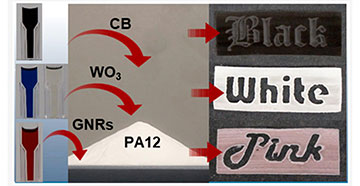
Laser sintered samples by using PA12 powder and gold nanoparticles (GNRs), tungsten oxide (WO3) and carbon-black-based sensitizers (CB). [Credit: ICFO]
Additive manufacturing, more commonly known as 3D printing, has found a place in many different industries due to advantages such as mass customization, rapid prototyping and waste minimization. One type of 3D printing called selective laser sintering (SLS) uses a carbon dioxide laser or diode laser to fuse small particles of powdered material to create 3D structures.
While performing SLS with a diode laser instead of a carbon dioxide laser is much cheaper, it restricts the color of the prints to black or gray. Now, a team of researchers in Spain has solved this issue by replacing the traditional carbon-based photothermal sensitizers with colorless tungsten oxide nanoparticles, which allows any colored inks to shine through in the final print (Nano Lett., doi: 10.1021/acs.nanolett.0c00414).
Color restrictions
Carl Deckard began to develop SLS as an undergraduate student at the University of Texas at Austin, USA, in the 1980s. He conceived a method to fabricate parts by using a laser to fuse together powder layer by layer. Today, SLS is capable of producing highly durable parts with complex geometries and has been adopted for applications like aerospace hardware, medical devices and wind-tunnel test models.
Typically, SLS requires a high-powered carbon dioxide laser, which makes the printer bulky and expensive. Low-cost, more compact solutions involve diode lasers but rely on carbon-based photothermal sensitizers to facilitate the sintering of polymer powders.
“Such technologies are employing carbon black as the sensitizer material, which, as the name suggests, results in objects that have a dark gray or black color, making it challenging to alter the aesthetics of the final object,” said senior author Gerasimos Konstantatos at ICFO–The Institute of Photonic Sciences, Spain. “We therefore sought to overcome this limitation.”
Switchable absorbers
In earlier work, the researchers found that gold nanorods could operate as a photothermal sensitizer with low-power light sources without significantly altering the aesthetics of the print. The resonant absorption of the gold nanorods was tuned into the near-infrared, allowing for minimal interaction with visible light. But they were not stable at high temperatures and had problems printing objects in pure white.
Konstantatos and his colleagues then thought about exploring switchable absorbers instead of permanent absorbers to generate heat. These would only possess strong optical absorption properties during the sintering process and would otherwise be transparent. They decided to experiment with tungsten oxide, a photochromic material with strong absorption in the near-infrared that could be efficiently switched on and off with exposure to ultraviolet radiation.
The researchers synthesized tungsten oxide nanoparticles and mixed them with commercial additive-manufacturing powders. They put the new photochromic nanocomposite powder to the test against a composite powder with carbon black by illuminating small samples with an LED array. While the carbon black composite heated more effectively than the nanocomposite, the former also induces a much greater change in coloration. The photochromicity of tungsten oxide means that the nanocomposite was almost colorless once the excited state decayed.
A commercially viable solution
Tungsten oxide nanoparticles are easy to synthesize on a large scale, require inexpensive reactants and remain stable at high temperatures. Konstantatos and his colleagues believe the nanocomposite represents a commercially viable solution, and hope to increase its technology readiness level by developing a 3D printer that incorporates the technique with an ultraviolet light source.
“Our vision is to expand the concept of ‘smart materials’ that we have used here, from the processing and fabrication stage to the properties of the final object,” said Konstantatos. “Imagine, for example, a 3D-printed object that depending on the nanocrystals included would respond to different environmental stimuli by changing color, texture or even shape, making it essentially a sort of smart object.”
